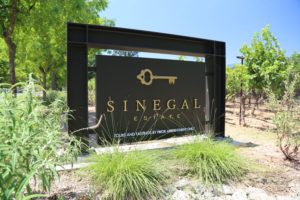
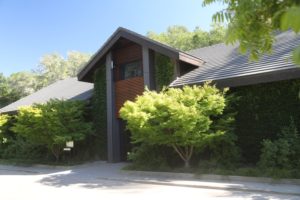
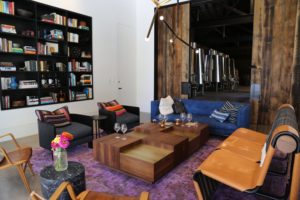 Sinegal Estate was founded in 2013 with the first release of wines under the Sinegal label from their 30 acre Inglewood estate in St Helena (not to be confused with the Inglenook Estate in Rutherford). This is not a new winery property by any means – it was part of an original land grant in this part of the valley and its more modern-day history dates back to 1879 when owner Alton Williams (died 1918) purchased the property and planted the first vines in 1881. An August 21, 1884, article in the St. Helena Star references Alton’s frame cellar that was completed that year with production on site up to 20,000 gallons. This same article references his interest in digging into the hillside and also building a two-story stone structure. By 1885 a clipping from the St Helena Star dating February 5, 1885, indicated various cuttings and vines were being sold from the property including the variety Mataro and what was called at the time, Black Pinot (Pinot Noir). Other local newspaper articles in the early to mid 1880s reference Williams having up to 24 acres of vineyards on his property including 18 acres of older vines and 6 acres of new vines he planted.
Sinegal Estate was founded in 2013 with the first release of wines under the Sinegal label from their 30 acre Inglewood estate in St Helena (not to be confused with the Inglenook Estate in Rutherford). This is not a new winery property by any means – it was part of an original land grant in this part of the valley and its more modern-day history dates back to 1879 when owner Alton Williams (died 1918) purchased the property and planted the first vines in 1881. An August 21, 1884, article in the St. Helena Star references Alton’s frame cellar that was completed that year with production on site up to 20,000 gallons. This same article references his interest in digging into the hillside and also building a two-story stone structure. By 1885 a clipping from the St Helena Star dating February 5, 1885, indicated various cuttings and vines were being sold from the property including the variety Mataro and what was called at the time, Black Pinot (Pinot Noir). Other local newspaper articles in the early to mid 1880s reference Williams having up to 24 acres of vineyards on his property including 18 acres of older vines and 6 acres of new vines he planted.
The large home at the time, referred to as the Inglewood House served as a summer hotel and a boarding school.
Alton was originally from New York, moved to Vallejo where he was employed by Southern Pacific Railroad Co. Later he was the long-time president of The Carver National Bank. He also lived in Hawaii for several years, involved in railroad operations and then later in Bakersfield working with his son in various oil related business.
The property has changed owners a number of times over the decades; at one point well-respected long time Napa family the Jaegers’ owned the estate. Bill Jaeger and his wife Lila purchased the property in 1965 and lived here; these Napa Valley winery pioneers were in part responsible for helping establish Freemark Abbey and Rutherford Hill. Layla was also a keen gardener and established some beautiful gardens on the property. Previous owners of the property were Jane and Doug Wolf of Wolf Family Vineyards (and Karen Culler was their winemaker).
Today a lawn grows where the first vineyard was planted in 1881. Old newspaper photos show vines growing right up to the steps of the historic home which was built 24 years later in 1906. A massive Douglas fir tree stands on the estate and is one of the largest trees of this kind we have seen anywhere – its trunk resembles the girth of a giant Sequoia.
Owners (father and son), David and James Sinegal purchased the property in 2013. James was the co-founder of Costco and one-time CEO; David worked at Costco for 21 years. In 2024 a Costco finally opened south of the city of Napa. Along with Total Wine & More, Costco is one of the largest buyers and sellers of wine in the U.SA. And its no surprise that some of the Sinegal wines are sold at this particular Costco as are other limited production wines from Napa Valley producers. And sometimes the wines sold here are significantly discounted over other retail locations.After the purchase, David soon set out to make his mark in the vineyards – dividing each of their vineyards into smaller blocks, picking selectively (30 times in 2013) rather than all at once, and adding technology to the vineyards so they have up to the date reports on a number of data points including temperatures, soil moisture and various barometric pressures. If they want to selectively water, say vine #67 in row number three, they can do so with their irrigation system.
Nine acres of vines are planted to various red varietals including Cabernet Sauvignon, Cabernet Franc, Malbec and Petit Verdot. They have some of the older Cabernet Franc vines in the valley – at 30+ years old. The soils here are diverse and can vary even within small geographic ranges on the property. Some of their vineyards are planted on the valley floor – while their upper vineyards are hillside, on the edges of the Mayacamas Mountains. The Napa Land Trust borders the upper reaches of their property – a natural wooded hillside environment that will be preserved as is with no development taking place within its borders.
The landscape is interesting in this part of the Mayacamas mountains. Visually it appears drier than other parts of this mountain range and the vegetation reflects that – with grey pine, and more open natural vegetation rather than the thicker wooded vegetation more commonly associated with parts of Spring and Diamond Mountains to the north.
After purchasing the property – David created an ambitious plan and laid out his vision to create a world-class boutique wine making operation. Many wineries in the Napa Valley can take years before they come to fruition – not so here. After only about 10 months – the existing winery was significantly remodeled, 6,500 feet of caves were expanded and drilled into the hillside behind the winery – and a new intimate hospitality center was built. The hospitality center ties in very well with the winery – from the small tasting room, large doors open revealing the tanks.
A vegetable garden slightly under an acre in size grows just south of the winery building – vegetables from this garden are sold to nearby restaurants.
A skeleton key graces the labels of their wine and is prominently displayed on the outside of their winery building. This has historical significance – the original key opens the front door to the historic home on site and is displayed in the tasting room. With respect to the history of this property, this one key has already become iconic to the brand.
David is proud of the work that he is personally overseeing on the property, and rightly so. He has both preserved the estate’s unique heritage yet introduced state of the art facilities and wine making equipment to the property as well as set about micromanaging the vineyards – all while building a lifestyle for himself and at the same time ultimately creating a beautiful environment for visiting guests.
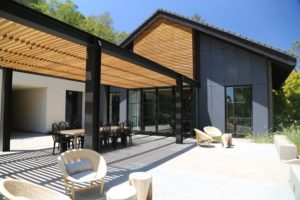
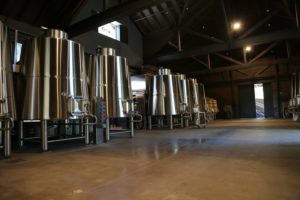 One needs to look no further than the inside of the winery to see that their wine making team is focused on quality. Each of the small lot tanks have built in pumps which can be controlled and programmed to do pump-overs anytime of the day or night (built in pumps certainly are a time saver for employees). In addition, these tanks have multiple points at which the temperature can be controlled. These tanks do not necessarily handle all their fermentation’s – they also ferment small lots in puncheons and barrels as needed. Control across the board is the key here – and it is the control of the details in wine making that is is so integral from when the fruit first arrives through to when it is bottled. 2013 was their inaugural vintage.
One needs to look no further than the inside of the winery to see that their wine making team is focused on quality. Each of the small lot tanks have built in pumps which can be controlled and programmed to do pump-overs anytime of the day or night (built in pumps certainly are a time saver for employees). In addition, these tanks have multiple points at which the temperature can be controlled. These tanks do not necessarily handle all their fermentation’s – they also ferment small lots in puncheons and barrels as needed. Control across the board is the key here – and it is the control of the details in wine making that is is so integral from when the fruit first arrives through to when it is bottled. 2013 was their inaugural vintage.
Select Wines
Whites
The 2013 Sinegal Estate Sauvignon Blanc was sourced from the estate – but then it was determined it was growing in an area better suited for red varieties, so these vines were removed, and new plantings were made in the back of the property. While not far from these original plantings, the present home for their Sauvignon Blanc features different soils and is growing in a cooler part of the property. The wine making team has been experimenting with the style of this variety since 2013 with subsequent vintages seeing more oak – especially using the slightly longer ‘cigar’ shaped barrels (valuing the extra surface area for maximizing complexities including textural feel imparted from aging the wine on the lees in these particular barrels).
The 2014 Sauvignon Blanc shows aromas of lemon lime, gooseberry, citrus blossom and tantalizing nuances of both of freshly mowed and dried grass (think of these aromas on a warm dry summer’s day). This wine is balanced on the palate with flavors of melon and citrus; it is lively, flavorful and shows very good acidity perhaps tempered slightly by the additional oak in this vintage (vs the 2013). Texturally it is soft and rounded on the palate – almost velvety.
Reds
Phenolics (color, tannins and mouth feel) are very important in their wine making program – both in the vineyard and in the winery. Maceration on the red wines is often 8-10 days – with sometimes up to 20 days.
The 2021 Sinegal Cabernet Sauvignon, Napa Valley is 86% Cabernet Sauvignon, 5% Petit Verdot, 4% Cabernet Franc, 3% Malbec and 2% Merlot. This wine was aged for 20 months is 80% new French oak barrels. It is deep ruby and opaque; the heady bouquet offers a diversity of dark and ripe fruits including blackberry, boysenberry, cherry, plum, cassis and mulberry. Additional aromatics include that of dark olive, cedar, pipe tobacco, mint (contributing a fresh/cooling character) and violets. As dark fruited on the palate as on the bouquet, there are flavors of blackberry, Santa Rosa plum, dark cherry and boysenberry. The well-tumbled and silky tannins are remarkably approachable in their youth considering 2021 in general, produced well-structured red wines from Napa Valley; we tasted this wine three years post harvest. The finish lingers with dark cocoa, a light drying character, dried herbs including smoked sage, dark pepper, tobacco and a woodsy spice. Its drinking window is now through the next 10-12 years.
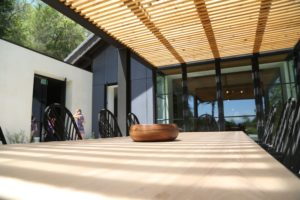
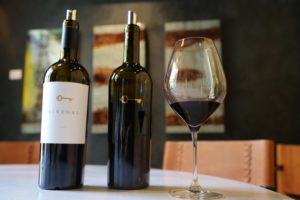 The 2013 Sinegal Estate Cabernet Sauvignon is priced reasonably, and was sold out at the time of our tasting. It is deep ruby in color and aromatically powerful with rich fruit (blackberry & raspberry) complemented by toasted cedar, darker chocolate and vanilla. The wine is plush on the palate and is already well balanced for both being so young and for this particular vintage from Napa Valley which was known for producing tightly woven and textural powerful red wines in their youth.
The 2013 Sinegal Estate Cabernet Sauvignon is priced reasonably, and was sold out at the time of our tasting. It is deep ruby in color and aromatically powerful with rich fruit (blackberry & raspberry) complemented by toasted cedar, darker chocolate and vanilla. The wine is plush on the palate and is already well balanced for both being so young and for this particular vintage from Napa Valley which was known for producing tightly woven and textural powerful red wines in their youth.
The 2013 Sinegal Estate Reserve Cabernet Sauvignon is a bigger and a more opulent wine; it is aged in different oak as compared to the primary Sinegal Estate Cabernet Sauvignon. Visually it is just as dark. Aromatically it shows darker fruit including black currant and blackberry framed by prominent toasted oak aromas. While initially it sports a velvet texture upon entry, the palate quickly becomes more complex in terms of both flavor and texture. For a robust bottling it features a pleasing balance of fruit, acidity and structure. Certain visual extras complement this inaugural Reserve wine; it is packaged in a premium walnut wood box and each bottle is individually numbered.
Note the number ‘1403’ on the bottles. With the help of several entities, David counted every single step to making wine at Sinegal Estate – from vineyard to winery to consumer. He enlisted the help of various mapping and other data collecting software to arrive at this auspicious number! While this number is a good assessment of the steps needed for Sinegal Estate; there is plenty of room for both art and science in a number such as this – and it of course varies from winery to winery.
Details
Sinegal Estate also produces Details, a brand focused on larger production and nationally distributed bottlings including a Cabernet Sauvignon and a Sauvignon Blanc from neighboring Sonoma County. These wines like some of the Sinegal bottlings are available at select Costco stores. Not many brands have the guts to prominently display a goats skull on the front of their label; however this skull is presented with some artistic liberty and visually ties into the common expression, “the devil is in the details”
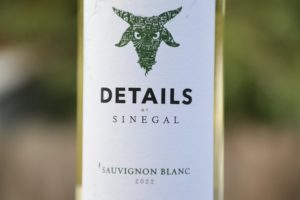
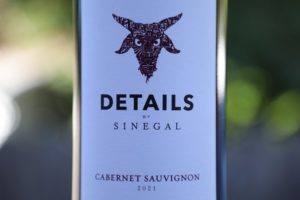 The 2022 Details by Sinegal Sauvignon Blanc North Coast is medium gold in color; the attractive bouquet smells like the variety with aromas of citrus blossom, lemon verbena, kaffir lime leaf, pomelo, grapefruit and freshly mowed lawn. Smells minerally. Its herbal but not overtly green or grassy. On the palate there are flavors of white peach, tangerine, pineapple, honeydew melon, Golden delicious apples, nectarines, apricot and tarragon. Its fleshy and plump palate sports a highly rounded feel, like running your fingers over a miniature schnauzer puppy’s fur. While not an overly complex Sauvignon Blanc, this wine clearly over delivers for the price. Drinks well by itself; all you need is a glass, a warm day and a pool for optimal satisfaction.
The 2022 Details by Sinegal Sauvignon Blanc North Coast is medium gold in color; the attractive bouquet smells like the variety with aromas of citrus blossom, lemon verbena, kaffir lime leaf, pomelo, grapefruit and freshly mowed lawn. Smells minerally. Its herbal but not overtly green or grassy. On the palate there are flavors of white peach, tangerine, pineapple, honeydew melon, Golden delicious apples, nectarines, apricot and tarragon. Its fleshy and plump palate sports a highly rounded feel, like running your fingers over a miniature schnauzer puppy’s fur. While not an overly complex Sauvignon Blanc, this wine clearly over delivers for the price. Drinks well by itself; all you need is a glass, a warm day and a pool for optimal satisfaction.
The 2021 Details by Sinegal Cabernet Sauvignon, Sonoma County (Knights Valley) is a blend of 80% Cabernet Sauvignon, 7% Petit Verdot, 5% Merlot, 4% Petite Syrah, 2% Cabernet Franc and 2% Malbec. This wine is deep ruby and nearly opaque; there is nothing shy about these aromatics as they burst from the glass immediatley upon pouring. Their scents including ripe notes of blackberry, boysenberry, Persian mulberry, dark plum and black cherry at the peak of its ripeness. These up front fruit characteristics play well with a note of toasted oak (but not woodsy). As the wine evolves additional layers are expressed including of vanilla, mocha and cocoa powder. The palate mirrors the bouquet to some extent, offering flavors of blackberry, dark plum, boysenberry and black cherry. The oak influence shows more on the palate, especially on the finish. It lingers savory with chalky/grainy textured tannins, dried herbs and darker spices including crushed pepper. This wine drinks well in its youth and over delivers on quality to price.
—
Interested buyers and collectors can join their estate list; three tiers are appropriately named after historic dates relating to the estate. Tier 2013, named in honor of when the Sinegal’s purchased the property, Tier 1965 in honor of when the Jaeger’s purchased the property and Tier 1881 paying tribute to when vines were first planted on site and the age of the yellow Victorian home.
Much of their sales are conducted direct to onsite visitors or through the Estate List – however they do selectively distribute in California, Florida, New York and Washington. For more information, to purchase wines or to request an appointment, visit: www.sinegalestate.com
Sinegal/Cathiard Lake
For more information visit: www.sinegalestate.com






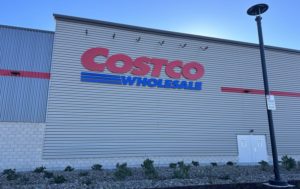
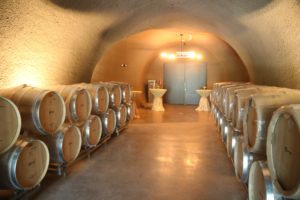
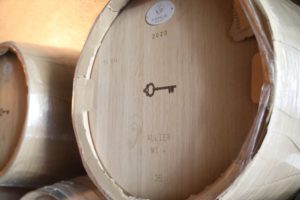
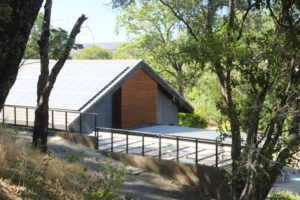
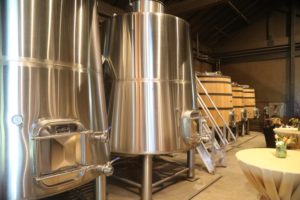
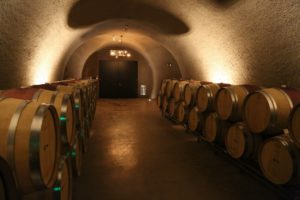
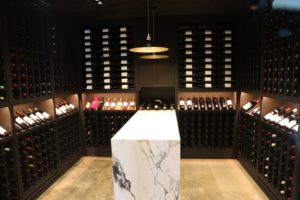
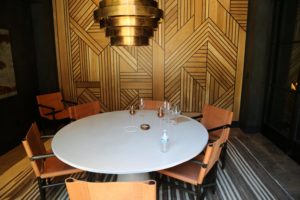
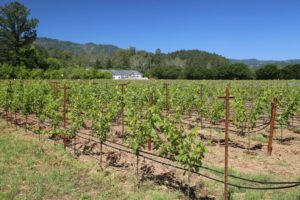
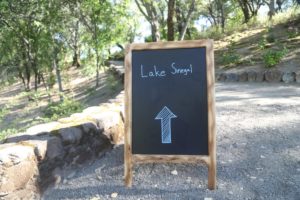
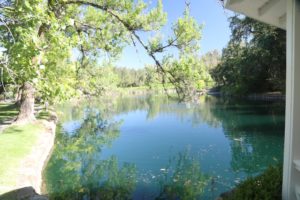
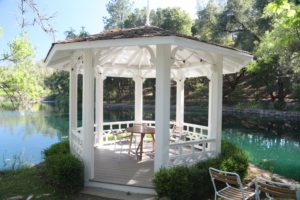
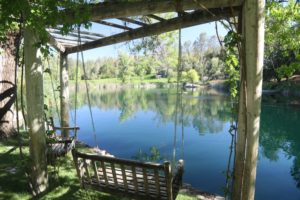
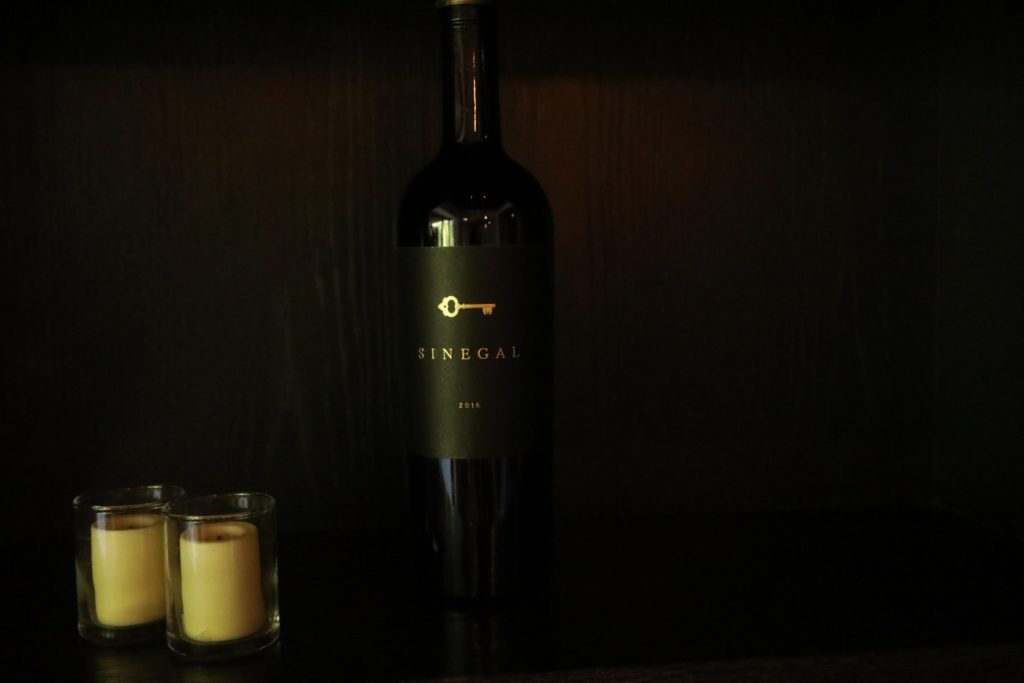
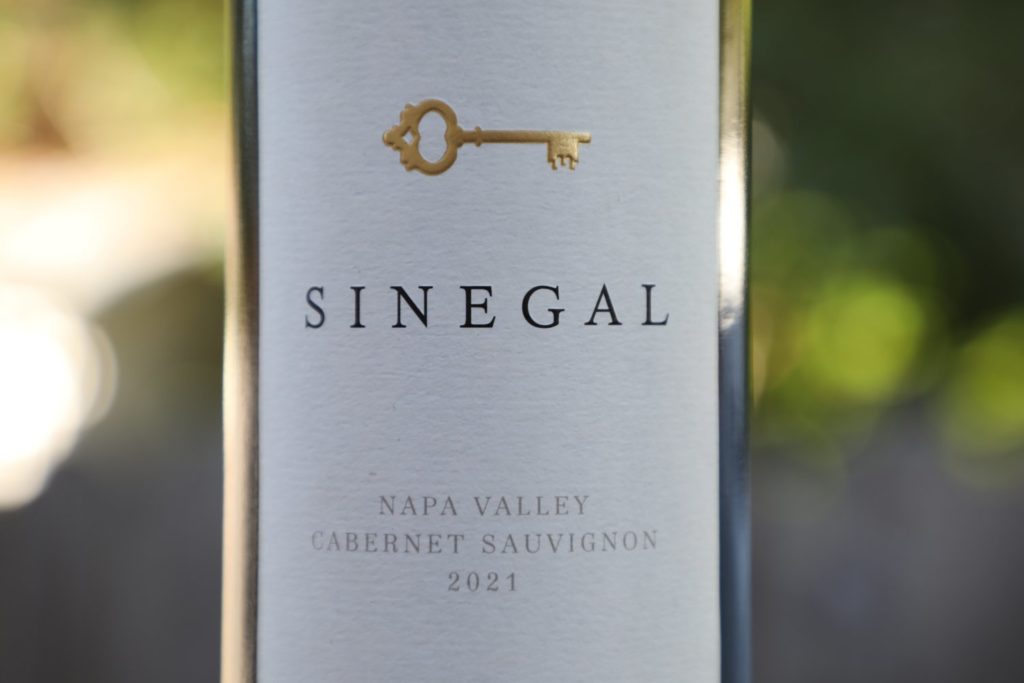
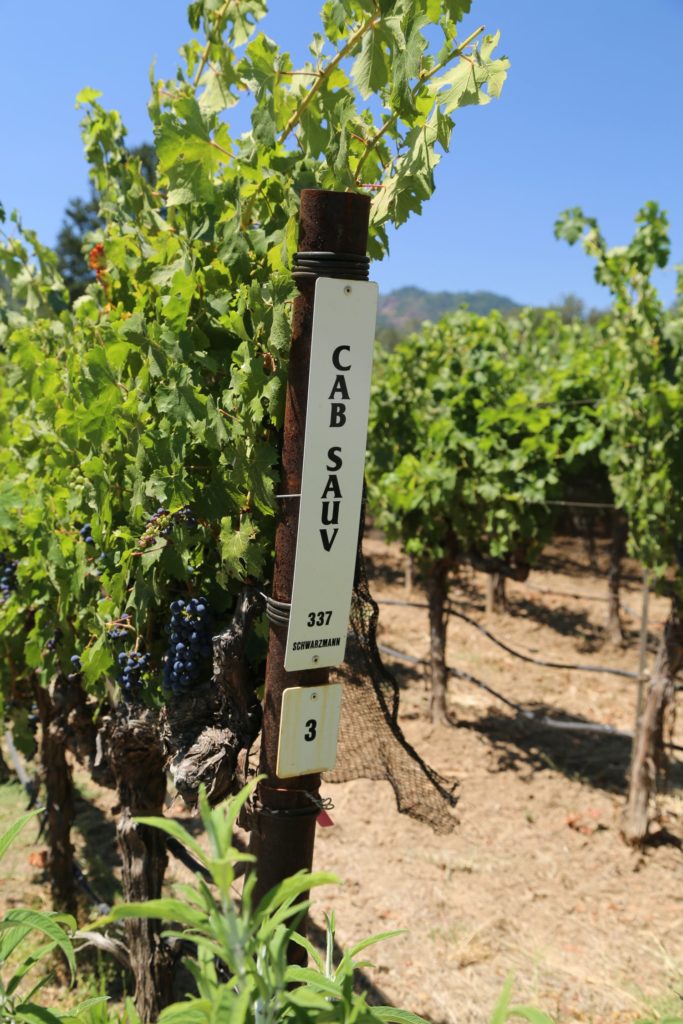
Dave, How do I get on your list to purchase Sinegal wines? I am interested as a wine lover, but also related to my long association with Costco as a supplier. Many, many years ago I supplied holiday gift wrap and more recently nutritional products in the form of snack bars and protein powders. I retired on 12/31/14 and last Fall I made one last West Coast trip and visited Costco, Starbucks and Clif Bars in CA on consecutive days. All these companies employ incredibly successful business models, but also have deeply ingrained values and a culture that always influences their practices. The trip was unbelievably stimulating from a coffee tasting at Starbucks of their proposed 2015 Christmas blend to wonderful conversations that went beyond product and price and touched on relationships and trust. Sorry, I got a little wound up. At any rate I found this same sense of purpose in the Sinegal Estate’s write up and I would like to be part of the story. Thanks for your consideration, Jack Rohrbach
Jack – I’ve forwarded your email on to David – I’m looking forward to the release of their first wines and when they finish the construction on the property 🙂
Hi Jack (and Dave),
Great comment. Always appreciate hearing stories like this.
We would love to have you join our mailing list. Here’s the direct link:
Thank you. Call us if you have any questions.
Eddie
707-244-1187 | info@sinegalestate.com
Eddie – good to “meet” someone else at Sinegal – I’ve only been communicating with David a few times. I look forward to staying updated the progress at the property 🙂
Mr David. We met briefly at Miami’s Four Seasons Lido. It was great chatting about wine and Condrieu😉😉 and happy you enjoyed the Pigato I suggested. Tasted the 17 and 18 cabs, the sauv Blanc and the Sonoma coast blend Chardonnay all very yummy.